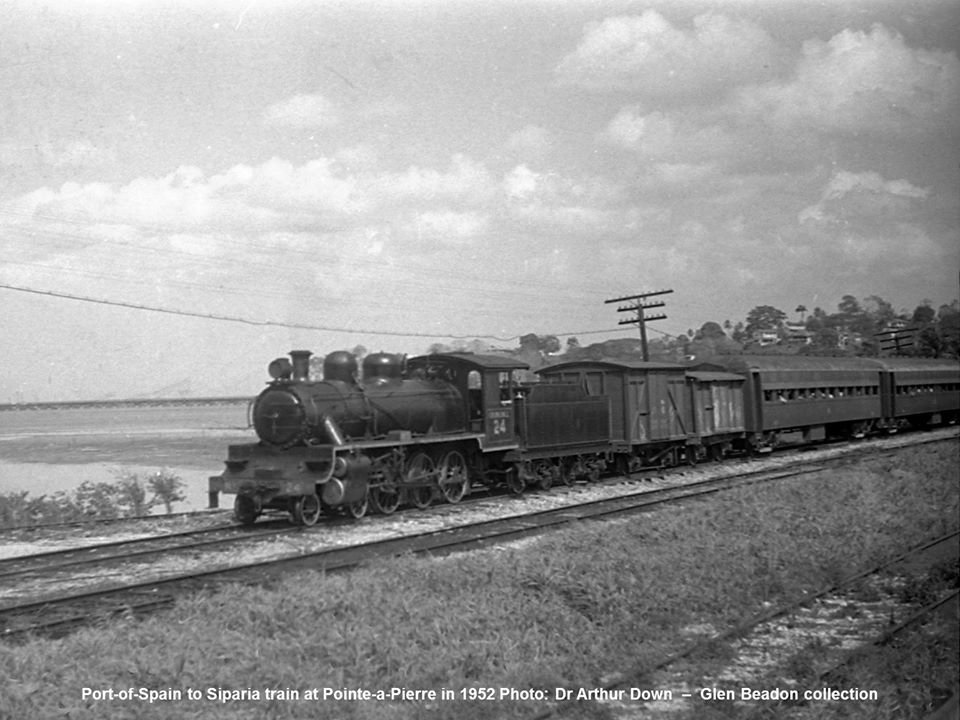 67 YEARS AGO, TODAY The closure of railways across Trinidad was a long drawn out process which was first discussed in 1920 when the TGR, that had opened in 1876, suffered its first year of financial losses after 45 years of profitable operation. Financial instability was largely due to the introduction of privately operated omnibuses for public transportation between 1908 and 1920. After WW1, there were also many private road haulage companies using surplus war equipment which greatly impacted freight traffic. Due to diminishing profitability on the railways, four separate economic enquiries were carried out by the Government in 1926, 1936, 1956 and 1963. The only improvement in the situation occurred when the railways proved “indispensable” during both world wars. It has often been said that railways in Trinidad were retained after 1936 due to the critical role it played during the second world war when it was saved by the Americans who used it to build and supply their base at Waller field. Despite efforts to arrest the decline by successive administrations, by 1950 the railway was in serious trouble once again. But the roads still had some way to go before they could completely substitute the railways especially when it came to the transportation of bulk commodities like sugar and very heavy oilfield apparatus for drilling and refinery. Nevertheless, the writing was on the wall and it seemed the “indispensability” of the Trinidad Government Railway was beginning to fade with each passing year. The critical role played by the railway during both World Wars was being quickly forgotten in the face of post war economic realities. In the face of mounting criticism, the Government acted. On the 12 March 1953 came first closure announcements across the TGR. The Arima to Sangre Grande, San Fernando to Princes Town and San Fernando to Siparia lines were all to lose their passenger services. Substitution bus services were widely publicised in the lead up to closures. Closures came as had been announced on 1 April 1953 and on this date the Arima to Sangre Grande line was completely closed to both passenger and good (some Orange Grove bound cane traffic continued for a few more years). The Guardian reported on the last departure from Sangre Grande, which left the station at 9:15 pm on the evening of April 1st. “The last train gave three mournful blasts each lasting three to four minutes as a farewell”. Also, on the same day, 1 April, the San Fernando to Princes Town (Guaracara line) and the San Fernando to Siparia line both closed to passenger traffic. The Guaracara line lost its goods service on 8 June. These lines were closed despite much protest. In a twist of fate, the Siparia line was to hold on to its goods services, presumably in order to service the now booming oil industry and the sugar cane scales between Usine Ste. Madeleine and Penal. In the 1950s the road system in Trinidad was not yet suitable for the transportation of heavy refinery equipment and drilling oilfield apparatus and reliance for this was placed on rail as was the transportation of bulk cane to Factory. During the course of its life the Siparia line brought many people to the district from all points of the railway network particularly during the yearly festival of La Divina Pastora when many extra trains, known as “Specials”, were put on in order to accommodate the high volume of traffic. This practice continued for several years following the withdrawal of passenger trains to Siparia in 1953 and there was a brief resumption of a passenger service 1964 when the authorities in Siparia petitioned the need to provide transportation for school children to and from San Fernando, this service only lasted a very short time. The reality was that people in the 1960s stopped using the railway. The route taxi became very fashionable and people saw it as a status symbol. Many will argue with me over this; however, one only must ask the old TGR workers and the argument becomes clear. People were not using the service. Trains ran empty except for periods of “rush hour” or perhaps during Carnival time. Within the final years, no service was more abused physically and verbally, than the railway. “Deficit-ridden,” “not economically viable”, “a drain on the economy.” “barren, bankrupt and archaic,” were some of the terms used by the public and press to describe the service. Physical abuse was perpetrated by vandals, and by the thousands who travelled daily without paying fares because of the dated ticket examination system in operation. This contributed greatly to its demise. Despite closures and measures designed to arrest the demise, losses over the final years continued; in 1964 the service lost $3.6m; in 1965 3.2m; in 1966 2.7m; in 1967 1.6m; and in 1968 (final year) $1.2m. A Cabinet-appointed committee which examined the railway, with special reference to closure, dismissed the possibility of the service ever becoming viable. In 1968 officials of the Public Transport Service Corporation, which operated the railway, reported on the unsafe condition of the rail tracks as the key reason why the service could not be retained. The cost of rehabilitating the service and making it safe was put at $590,000, money which "could be better utilised in providing a more efficient bus service". Personally, I believe that had the railway managed five more years of operation after 1968 there may have been a return to the rails by the public as our road traffic situation in and out of Port of Spain began to deteriorate. I'm sure the debate will continue for many more years to come. Source: Glen Beadon 1 April 2020 VM of T&T
0 Comments
Leave a Reply. |
T&T news blogThe intent of this blog is to bring some news from home and other fun items. If you enjoy what you read, please leave us a comment.. Archives
November 2024
Categories
All
|

 RSS Feed
RSS Feed